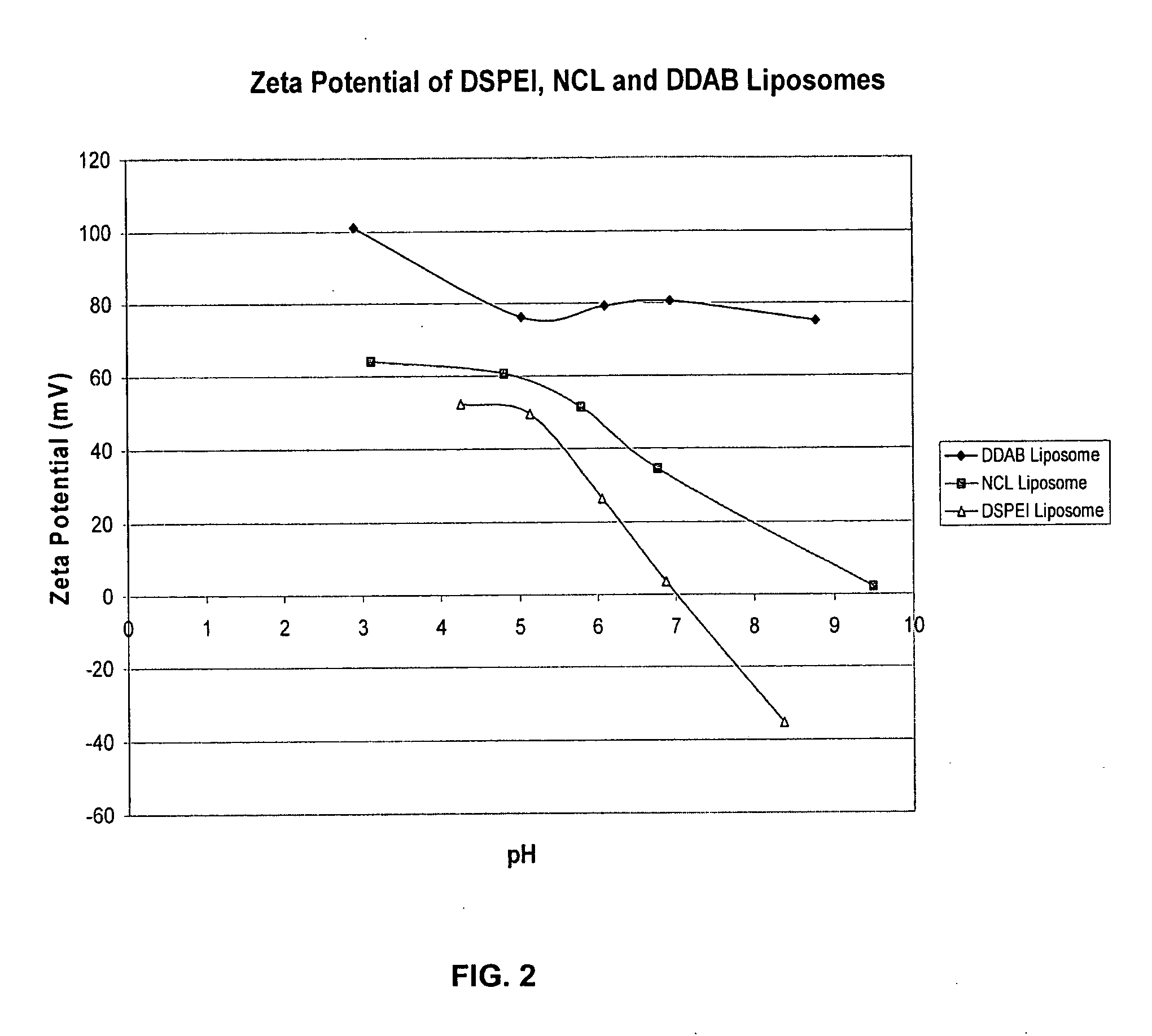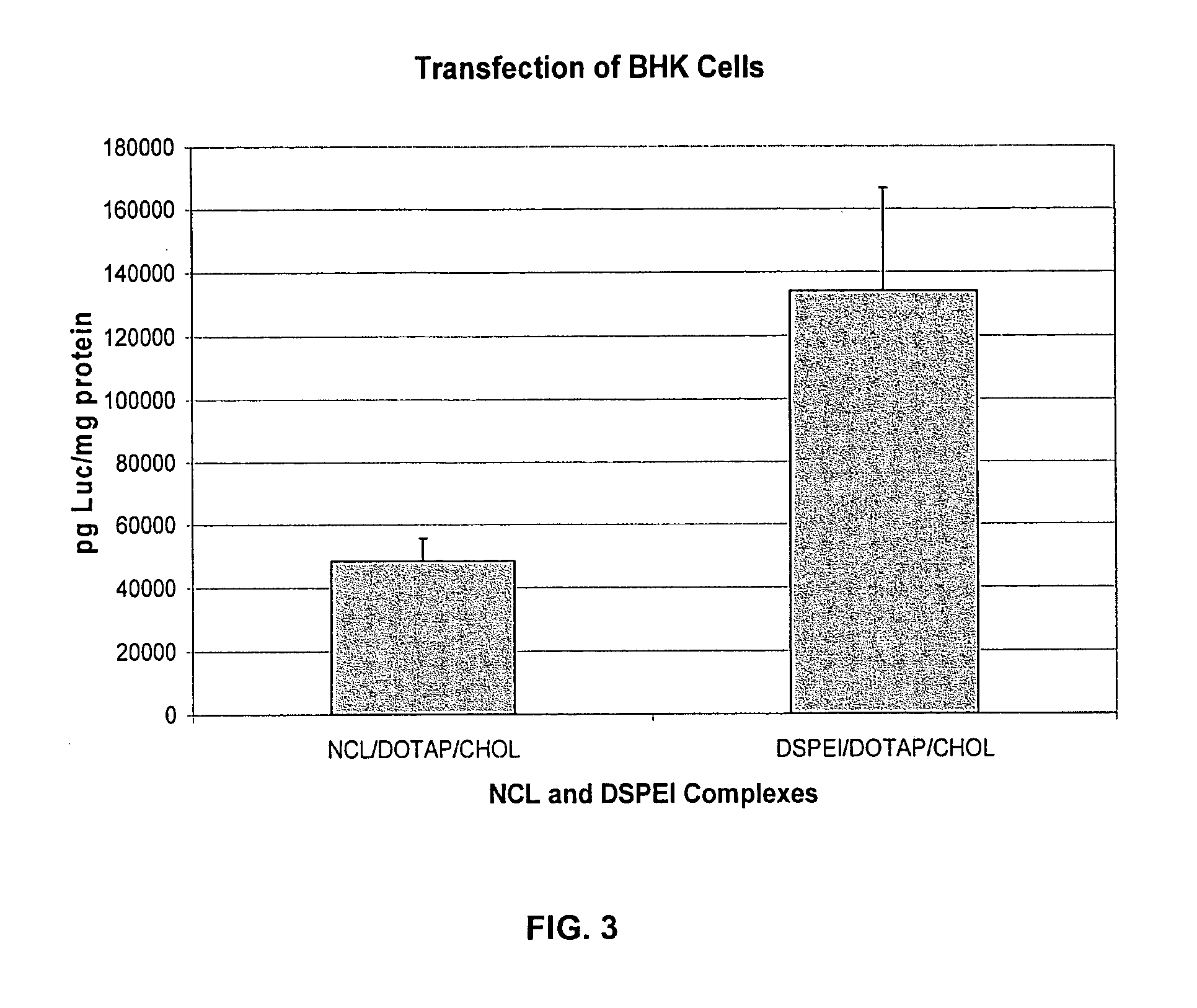Liposome composition for delivery of therapeutic agents
a technology of liposomes and compositions, applied in the direction of drug compositions, group 5/15 element organic compounds, genetic material ingredients, etc., can solve the problems of undesirable sites, inability to deliver genes to systemic sites of disease, and easy entrapment in the lung, so as to and prolong the circulation time of liposomes
- Summary
- Abstract
- Description
- Claims
- Application Information
AI Technical Summary
Benefits of technology
Problems solved by technology
Method used
Image
Examples
example 1
Preparation of Exemplary Neutral-Cationic Lipid
Preparation of Imidazolyl Derivatized Distearoylphosphatidylethanolamine
[0147]
[0148] 4(5)-Imidazole carboxaldehyde (Aldrich, 0.06 g, 0.6 mmol) and distearoylphosphatidylethanolamine (DSPE) (0.39 g, 0.52 mmol) were dissolved in a mixture of CHCl3:CH3OH (1:1 v / v, 16 ml) at 50° C. for 15 min. To the above mixture, borane-pyridine complex (0.05 ml, 0.6 mmol) was added drop wise and the reaction mixture was stirred at 50° C. for 3 hrs and then at room temperature for 18 hrs. The TLC (CHCl3:CH3OH: H2O, 80:18:2) of reaction mixture showed that the reaction went to completion. The solvent was evaporated and the crude mixture obtained was chromatographed using silica gel. CHCl3:CH3OH (80:18) was used as an eluent to remove upper impurities followed by CHCl3:CH3OH:H2O (80:18:2) solvent system to elute the white solid product which was lyophilized from tertiary butanol. The yield of product was 0.37 g, (86%). 1H NMR (CDCl3): δ 0.878 (t, 6H, CH3)...
example 2
Preparation of Diimidazole Phosphatidylethanolamine
[0149] The same procedure was utilized as described in Example 1, with double the amount of imidazole carboxaldehyde (1 mmole) and borane-pyridine (1.1 mmole), to produce the titled derivative. The di-imidazole product was purified by chromatography on silica gel and characterized by MALDI-TOF mass spectrometry. The product had a molecular weight of 907 g / mol indicative of two imidazole moieties attached to the quaternary amine of phosphatidylethanolamine. This reaction is also depicted schematically in FIG. 1. The same 1H NMR spectrum was seen as described in Example 1, with integration confirming the presence of two imidazole moieties.
example 3
Preparation of Liposomes Containing DSPEI and PHSPC
[0150] DSPEI and PHSPC were mixed at the molar ratio of 40:60 and were dissolved in chloroform. Chloroform was evaporated with rotary evaporation in order to form a lipid thin film. Lipid thin film was hydrated with pH ˜4.5 water for 30 min at ˜40° C. The resulted multi-layer liposomes were sonicated for ˜10 min, and final liposome size was around 80 nm.
PUM
| Property | Measurement | Unit |
|---|---|---|
| Size | aaaaa | aaaaa |
| Mass | aaaaa | aaaaa |
| Mass | aaaaa | aaaaa |
Abstract
Description
Claims
Application Information
 Login to View More
Login to View More - R&D
- Intellectual Property
- Life Sciences
- Materials
- Tech Scout
- Unparalleled Data Quality
- Higher Quality Content
- 60% Fewer Hallucinations
Browse by: Latest US Patents, China's latest patents, Technical Efficacy Thesaurus, Application Domain, Technology Topic, Popular Technical Reports.
© 2025 PatSnap. All rights reserved.Legal|Privacy policy|Modern Slavery Act Transparency Statement|Sitemap|About US| Contact US: help@patsnap.com



